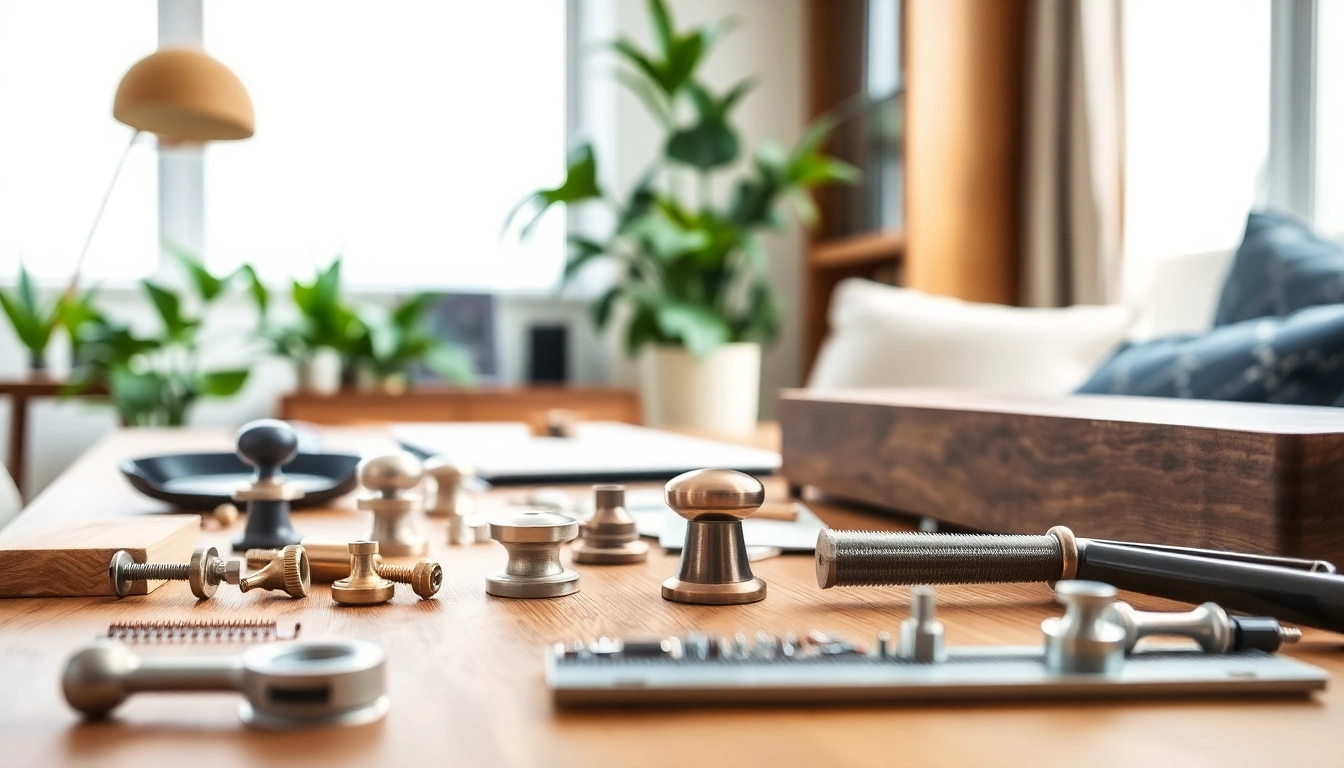Understanding Furniture Hardware Manufacturers
What Are Furniture Hardware Manufacturers?
Furniture hardware manufacturers are specialized companies that produce the various components and fittings used in the construction and assembly of furniture. This category encapsulates a broad range of products, from hinges and drawer slides to knobs, handles, and legs. These manufacturers play a crucial role in the furniture industry, providing essential hardware that not only enhances functionality but also contributes to the overall aesthetic appeal of furniture items. As consumers increasingly prioritize both style and practicality, the demand for high-quality furniture hardware has surged, driving innovation among manufacturers.
The Role of Manufacturers in Furniture Design
The role of manufacturers in furniture design extends beyond mere production. They are integral partners in the design process, working closely with furniture designers and architects to produce hardware that meets specific project requirements. This collaboration often leads to the creation of unique hardware solutions that reflect current trends and consumer preferences. Furthermore, manufacturers can influence the durability and ease of use of furniture through their choices in materials and design, thus playing a pivotal role in functional aestheticism.
Types of Products Offered by Furniture Hardware Manufacturers
Furniture hardware manufacturers offer an extensive range of products tailored to meet varying needs. Some key categories include:
- Hinges: Essential for doors and cabinets, available in various styles, such as concealed, pivot, and European hinges.
- Drawer Slides: Critical for smooth functionality, they come in several types, including side mount, under mount, and full-extension slides.
- Knobs and Pulls: These decorative components enhance furniture aesthetics while providing practical functionality for drawers and cabinets.
- Furniture Legs: Available in various styles and materials, they impact both stability and design.
- Locks: Used to secure furniture, particularly in office and storage units.
Key Players in the Furniture Hardware Industry
Top Furniture Hardware Manufacturers You Should Know
Within the furniture hardware sector, several manufacturers stand out due to their commitment to quality, innovation, and customer satisfaction. Some of the leading companies include:
- Top Knobs: Known for their wide range of premium cabinet and drawer hardware, Top Knobs offers diverse styles to complement various design themes.
- Rockler: A well-recognized name in woodworking and home improvement, Rockler provides a vast selection of drawer slides, hinges, and cabinet hardware.
- Furnica: As a prominent manufacturer in the USA, Furnica specializes in a broad array of furniture accessories, including innovative hinges and easy-to-install drawer slides.
- Richelieu Hardware: Offers avant-garde designs including pulls, knobs, and other specialty hardware products, contributing to contemporary furniture aesthetics.
- Hardware Resources: This company designs and manufactures various hardware solutions focusing on kitchen cabinets and closet industries.
Comparative Analysis of Leading Brands
When evaluating different furniture hardware manufacturers, it is essential to consider several factors:
- Product Range: Brands like Top Knobs and Rockler provide extensive options, while others may specialize in niche products.
- Quality Assurance: Companies like Furnica and Richelieu emphasize quality through rigorous testing and premium materials.
- Design Versatility: Brands such as Amerock and Baldwin focus on aesthetics and functionality, offering products that fit a variety of design styles.
Unique Value Propositions of Each Manufacturer
Each manufacturer brings unique value to the market:
- Top Knobs: Recognized for their stylish and durable designs, appealing to both traditional and contemporary tastes.
- Rockler: Combines affordability with an extensive DIY selection, making it a go-to for hobbyists and professionals alike.
- Furnica: Offers innovative and practical solutions for furniture construction, backed by a user-friendly online shopping experience.
- Richelieu Hardware: Stands out for its cutting-edge design and a wide variety of niche products catering to specialized projects.
- Hardware Resources: Focuses on quality craftsmanship in hardware, ensuring a high level of satisfaction in residential and commercial applications.
Factors to Consider When Choosing Hardware
Quality and Durability of Furniture Hardware
Quality and durability are paramount when selecting furniture hardware. The longevity of hardware can significantly impact the furniture’s overall lifespan. When assessing these factors, look for:
- Material Composition: High-grade materials such as stainless steel and zinc alloys often ensure better durability.
- Finish Quality: A well-applied finish can prevent corrosion and enhance visual appeal.
- Performance Testing: Some manufacturers provide data on load-bearing capabilities and testing standards, offering insight into product reliability.
Style and Aesthetic Compatibility
Style plays a crucial role in hardware selection. Factors to consider include:
- Design Cohesiveness: Hardware should complement the furniture design and the overall room aesthetic.
- Color Matching: Hardware finishes should match or harmonize with surrounding materials, be it wood stains, paint, or tile.
- Trends and Preferences: Keeping an eye on current design trends can help create a more appealing final look.
Cost-effectiveness and Value for Money
While quality is essential, cost is also a significant factor. To ensure value for money, consider:
- Purchasing in Bulk: Many manufacturers offer discounts on bulk orders, making projects more economical.
- Warranty and Return Policies: Evaluating warranty terms can indicate the manufacturer’s confidence in their product.
- Balance between Price and Quality: Avoid compromising quality for a lower price; a small investment in quality hardware can save significant costs in the long run.
Trends Shaping the Furniture Hardware Market
Emerging Styles and Designs in Hardware
Emerging styles and innovative designs continue to shape the furniture hardware landscape. Trends include:
- Minimalism: Simple, clean lines without excessive embellishment are gaining popularity, reflecting a modern aesthetic.
- Vintage and Retro Influences: An increasing number of consumers are embracing nostalgic designs that offer character and uniqueness.
- Mixed Materials: Combining different materials like metal and wood is becoming more common, allowing for creative and diverse hardware selections.
Sustainability in Furniture Hardware Manufacturing
As environmental concerns rise, sustainability in manufacturing processes is increasingly important. Key considerations include:
- Recyclable Materials: Manufacturers are now utilizing recycled metal and eco-friendly finishes.
- Energy-efficient Production: Executing production processes that minimize waste and energy usage is becoming a standard practice.
- Long-lasting Products: Creating durable hardware reduces the need for frequent replacements, hence minimizing environmental impact.
Impact of Technology on Hardware Production
Technology continues to transform furniture hardware production, leading to innovations in design, efficiency, and functionality. Notable advancements include:
- 3D Printing: Manufacturers are increasingly utilizing 3D printing capabilities for prototyping and customized hardware solutions.
- CNC Machining: Computer Numerical Control (CNC) machines offer precision cutting that enhances quality and allows for complex designs.
- Smart Hardware: Innovative solutions featuring sensors and connectivity are emerging to improve functionality, particularly in high-tech homes.
How to Integrate Hardware Seamlessly in Your Projects
Choosing the Right Hardware for Various Furniture Types
Selecting the right hardware is paramount to ensuring functionality and style in furniture projects. Key aspects to consider include:
- Identify the Purpose: Understand whether the furniture is for residential use, commercial use, or bespoke projects, as each may require different hardware characteristics.
- Evaluate Compatibility: Ensure that the selected hardware will fit seamlessly with the furniture type, dimensions, and style.
- Consult with Professionals: When in doubt, input from experienced craftsmen can provide valuable insights into effective hardware choices.
Best Practices for Installation and Maintenance
To ensure longevity and functionality, adhere to best practices during installation and maintenance:
- Follow Manufacturer Guidelines: Always refer to the installation instructions provided, as they can vary significantly between products.
- Use Proper Tools: Employ the right tools to avoid damaging the hardware or furniture during installation.
- Regular Maintenance: Periodic checks and maintenance can prolong the life of furniture hardware. Clean hardware and check for any signs of wear or damage.
Real-life Examples and Case Studies
Employing the right hardware can make a substantial difference in furniture projects. For example, a mid-century modern-style furniture line successfully utilized tailored hardware that matched their design ethos. By selecting brass knobs and minimalist chrome pulls, the line captured both functionality and style. Additionally, a custom storage solution for a commercial space integrated soft-close drawer slides, offering a premium user experience while ensuring durability.















Leave a Reply